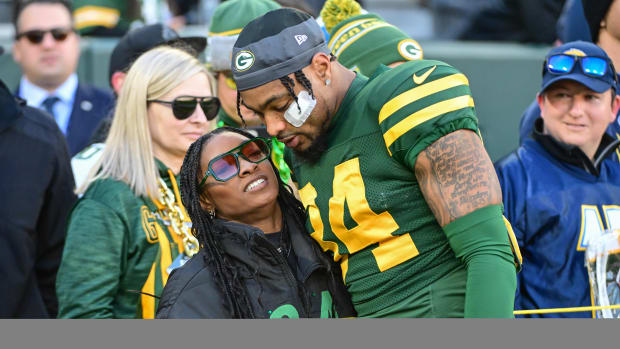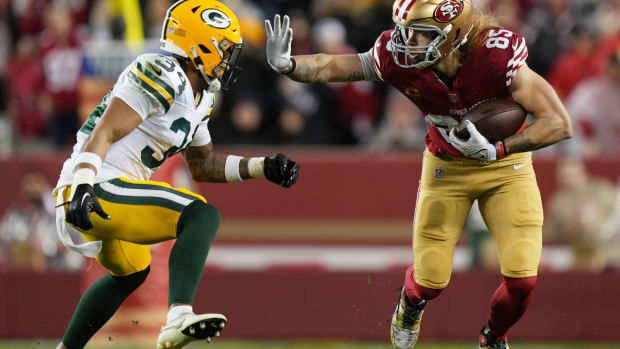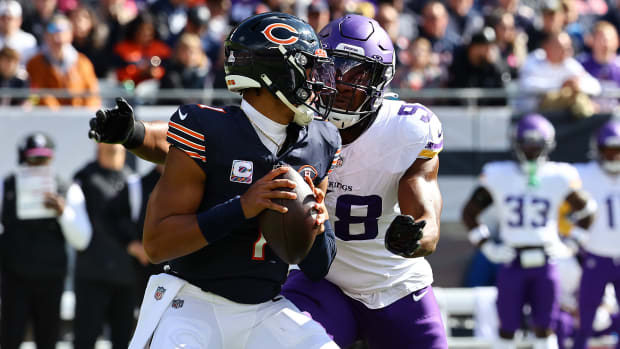Best Way for Quick Bears Turnaround
When last season ended, all of the league's losing teams wanted to be the Cincinnati Bengals and come from nowhere to win a conference championship.
Of course, the Bears are one of those losing teams but it's not really the Bengals they seem equipped to imitate if they want a rapid turnaround. Sure, Joe Burrow did all of this in his second season after injury derailed his rookie year, much the way Justin Fields made only 10 starts last year as a rookie. In that way they are similar.
However, Burrow had the advantage of a coaching staff in place with tons of supporting high draft picks for the third year of a rebuild. It was Burrow's second year in the same offense.
The Bears can't duplicate this in 2022 but they can still accomplish a turnaround by following the lead of another playoff team from 2021.
The template exists for a rapid turnaround in 2022, not in 2023 when the Bears have so much salary cap space available. They simply need to become the 2021 Philadelphia Eagles.
The Eagles were a playoff team and finished 9-8 before losing in postseason. This year an influx of talent has the Eagles sitting in prime position to step forward and challenge Dallas in the NFC East.
Toss in the fact that assistant GM Ian Cunningham was with the Eagles when all of this occurred and they definitely are aware of how they can copy this format.
Here's why the Bears could follow the Eagles success formula.
1. Schedule
Heading into last year, the Eagles had the easiest schedule in the NFL based on opponents' winning percentage at .430. The Bears don't have that easy of a schedule but it's pretty soft at .471. Only seven teams have easier schedules.
The Bears have an incredible advantage if they can only get to the final five weeks near .500. They play four of their final five games at home with a bye in that period. They also are playing nine teams who had losing records in 2022.
2. Coaching and Change
It is possible to turn around a team's fortunes in one year with a new coach and Philadelphia proved it.
It's a new Bears staff with former Colts assistant Matt Eberflus as coach, just like the Eagles had last year with Nick Sirianni, a former Colts and Chargers assistant.
The Eagles were even worse in 2020 under Doug Pederson at 4-11-1 than the Bears were last year under Matt Nagy (6-11).
Philadelphia brought in a young offensive coordinator in Shane Steichen, who designed a ground-reliant offense based largely on the mobility of quarterback Jalen Hurts. Luke Getsy is now Bears offensive coordinator and is emphasizing a wide zone running attack to complement a QB who can run and throw. It's play-action, and to achieve play-action success they have to run the ball.
In one year, the Eagles went from 26th in scoring, 24th on offense and 23rd in rushing yards per attempt to 12th in scoring, 14th in yardage, fourth in yards per rush and first in rushing. Along the way, their running game success made it possible for Hurts to succeed at elevating the passing game from last in the NFL in net yards per attempt to 13th.
The Eagles defense in 2020 had been mediocre to terrible. They were 20th in scoring, 19th in yardage, 15th at overall pass defense, and 28th stopping the run. They gave up 7.8 net yards per pass attempt, 31st in the league. Under defensive coordinator Jonathan Gannnon in 2021 they improved to 10th overall on defense, went from last to 14th in net yards per pass attempt allowed and from 23rd against the run to ninth.
They still have work to do at intercepting passes as they finished 20th in the league at this, but it's a lot better than the 29th they were in 2020.
Could Eberflus and defensive coordinator Alan Williams do this with the Bears defense after switching systems to gut the 3-4 and an aging lineup? He already did far better in Indianapolis, where the Colts were 30th in scoring defense, yards allowed and rushing yards allowed, 28th against the pass and last in net yards against the pass under Chuck Pagano in 2017 but in the next year finished 10th in scoring, 11th in yards, eighth against the run and 20th in net passing yards allowed.
3. The QB Issue
If you think Fields can't duplicate or outperform the leap made by Hurts from Year 1 to Year 2, you haven't been watching either quarterback.
Fields already ranked better at downfield passing than Hurts, according to Pro Football Focus. Fields was ranked 20th, according to PFF, with an 87.7 grade. Hurts had an 82.8 grade.
Coming out of college, Fields had PFF grades of 91.5 in 2019 and 93.5. Hurts was at 91.6 in his final year.
Style-wise, both players can run and this is the main reason the Eagles ranked so high in rushing after being so low. Hurts ran for 784 yards on 139 carries. That's an awfully big chunk of the Eagles' 2,715 rushing yards. Fields could obviously gain 784 yards if necessary. Hurts ran a 4.59-second 40 in college and is a good runner. Fields ran 4.44 in the 40, and last year rushed for 420 yards in essentially 10 1/2 games played. It's never ideal to base an offense on a quarterback running because a running QB is one waiting to be injured. But it's what the Eagles did last year and Fields is capable of doing that.
Fields wouldn't need much of a leap in terms of passing efficency to equal what Hurts did, or go higher. Hurts had an 87.2 passer rating in his second year. The Bears would want and expect Fields to be even higher. An 87.2 rating isn't even what Mitchell Trubisky achieved in Year 2.
Hurts had a nice 7.3 yards per pass attempt. If Fields is as accurate throwing downfield as PFF numbers suggest, he wouldn't have trouble topping 7.3 in a run-based offense.
4. The Receivers
It's perceived the Bears didn't help Fields much at receiver. His wide receivers are at least as good now, if not better, than the Eagles had last year.
Philadelphia's DeVonta Smith is explosive and was the top Eagles receiver last year with 64 catches and 916 yards.
Darnell Mooney is an inch shorter and three pounds heavier than Smith and has already had more catches and yards in a season than Smith had last year.
Speed-wise, they're comparable. No one timed Smith because the combine got canceled that year, but estimates range from 4.3-4.5 in the 40. Mooney was 4.38. Sure, it was Smith's first year, but remember, we're not talking about what Smith will eventually be, but instead what he was last year when he was Hurts' best target with those numbers. And he didn't have as many catches or yards as Mooney last year.
Hurts' second-best wide receiver had 43 catches (Quez Watkins). Byron Pringle had 42 for the Chiefs last year playing only part time and will play full time now for the Bears. The Eagles had no one on the receiver corps last year who compared physically and potentially to what rookie Velus Jones might be able to do for the Bears this year.
The Eagles tight ends surely were better than anything these Bears could offer, right?
Then again, Dallas Goedert made only 56 catches last year, four fewer than Cole Kmet. We're comparing to last year only, again. Zach Ertz before his trade, Jack Stoll, Tyree Jackson and Richard Rodgers combined for 27 Eagles receptions. Both Bears tight ends James O'Shaughnessy and Ryan Griffin can—and have—topped that total for a season by themselves during their careers.
5. The Backs
The top Eagles running back last year was Miles Sanders with 754 yards. David Montgomery is a better back, flat out. Sanders has 818, 867 and 754 yards and not in any season has he gained more yards than Montgomery.
Khalil Herbert had more yards rushing as a rookie last year than either Boston Scott or former Bear Jordan Howard had last season for the Eagles. The Eagles were deeper at back, but it's difficult to compare the depth since the third and fourth Bears backs haven't even really played yet just as Kenneth Gainwell hadn't played for the Eagles before last year.
In the end, the Bears this year can at least duplicate or top what the Eagles did on offense at every skill position last year. This isn't the problem.
6. The Root of the Problem
The only thing preventing the Bears from accomplishing any of this is their offensive line. If they find the right mix and block the run effectively, everything is possible.
Can such a thing even be done without overhauling personnel and bringing in a ton of draft picks? The Eagles did it.
The only blocker on Philadelphia's 2021 offensive line who hadn't been with them before last year was guard Landon Dickerson, and he wasn't even a starter initially but came on after a season-ending injury to Isaac Seumalo. Dickerson was a second-round pick who played well.
The Eagles were ranked by Pro Football Focus as having the 19th best offensive line at the end of the 2020 season. Then they lost Jason Peters. They got much better on the line with a new system of blocking and almost all the same players. Now they are regarded by PFF as the No. 1 line in the NFL.
The Bears are ranked 31st by PFF on the offensive line.
How much line coach Chris Morgan and offensive coordinator Luke Getsy can do to change those fortunes is the key to this Bears season, because all of the rest of the ingredients to follow the template for Philadelphia's single-season turnaround do exist.
Twitter: BearDigest@BearsOnMaven






